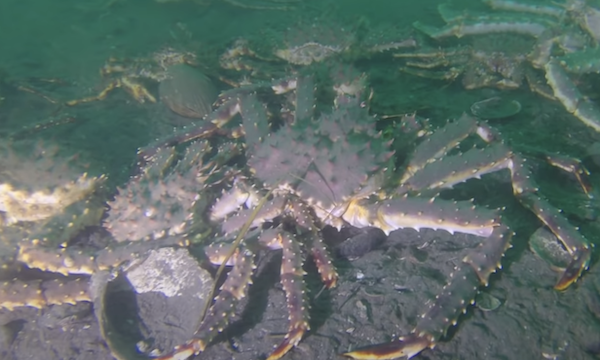| Crustaeceans and Marine Arthropods |
| Horsehoe Crab |
| Christmas Island Crab |
| Coconut Crab |
| Hermit Crab |
| Fiddler Crab |
| Alaskan King Crab |
| American Lobster |
| Rusty Crayfish |
|
In the frigid depths of the Bering Sea, a creature of colossal proportions and culinary delight reigns supreme—the Alaskan King Crab. Revered for its colossal size, succulent meat, and unmistakable taste, the Alaskan King Crab is a jewel of the Arctic waters, sought after by seafood enthusiasts and chefs worldwide.
Majestic Size and Species: The Royal Residents of Alaskan Waters
The Alaskan King Crab comprises several species, including the most renowned: the red king crab (Paralithodes camtschaticus), blue king crab (Paralithodes platypus), and golden king crab (Lithodes aequispinus). Renowned for their colossal size, these crustaceans can have leg spans exceeding five feet and weigh up to 24 pounds, making them the giants of the crab world.
Bering Sea Kingdom: Habitat and Range of the King Crab
The icy waters of the Bering Sea off the coast of Alaska provide the ideal habitat for the Alaskan King Crab. The crab's range extends from the Aleutian Islands to the Gulf of Alaska, where the cold temperatures and nutrient-rich currents create an environment conducive to their growth and development.
Predatory TendenciesThe diet of the Alaskan King Crab is primarily carnivorous, reflecting its role as a formidable predator in the icy depths of the Bering Sea. These colossal crustaceans are opportunistic feeders, preying on a variety of marine organisms found on the ocean floor. Their diet typically includes small fish, clams, snails, worms, and other bottom-dwelling creatures. Alaskan King Crabs are equipped with powerful claws that aid in capturing and consuming their prey. Despite their impressive size, the king crabs are also scavengers, feasting on carrion and detritus that they encounter on the ocean floor.
Culinary Delight: The Sweet and Succulent Meat of the King Crab
The allure of the Alaskan King Crab extends beyond its imposing size. Renowned for its delicate, sweet, and succulent meat, the king crab is a prized ingredient in the culinary world. The clusters of meat found in the crab's legs and claws are particularly sought after, providing a delectable addition to various dishes, from crab legs served with butter to more intricate seafood creations.
Commercial Harvesting: The Industry of King Crab Fishing
The commercial harvesting of Alaskan King Crab is a significant industry that contributes to the economy of the region. The king crab fishing season, typically occurring in the fall and winter, sees the deployment of fishing vessels equipped with traps and pots designed to capture these majestic creatures. Despite the economic benefits, sustainable fishing practices and strict regulations are essential to ensure the long-term health of king crab populations.
Challenges and Conservation: Balancing Harvest and Habitat Preservation
The popularity of Alaskan King Crab has led to concerns about overfishing and its impact on the crab population and their ecosystem. Conservation measures, including quotas, size limits, and seasonal closures, are implemented to strike a delicate balance between satisfying consumer demand and preserving the natural habitat and population dynamics of the king crab.
Economic Impact and Culinary Legacy: From Ocean to Table
The Alaskan King Crab fishery not only contributes significantly to the economy of Alaska but also plays a crucial role in the culinary world. The prized crab legs, with their rich, flavorful meat, are featured in high-end restaurants and seafood markets globally, creating a culinary legacy that showcases the bounty of the Bering Sea.
